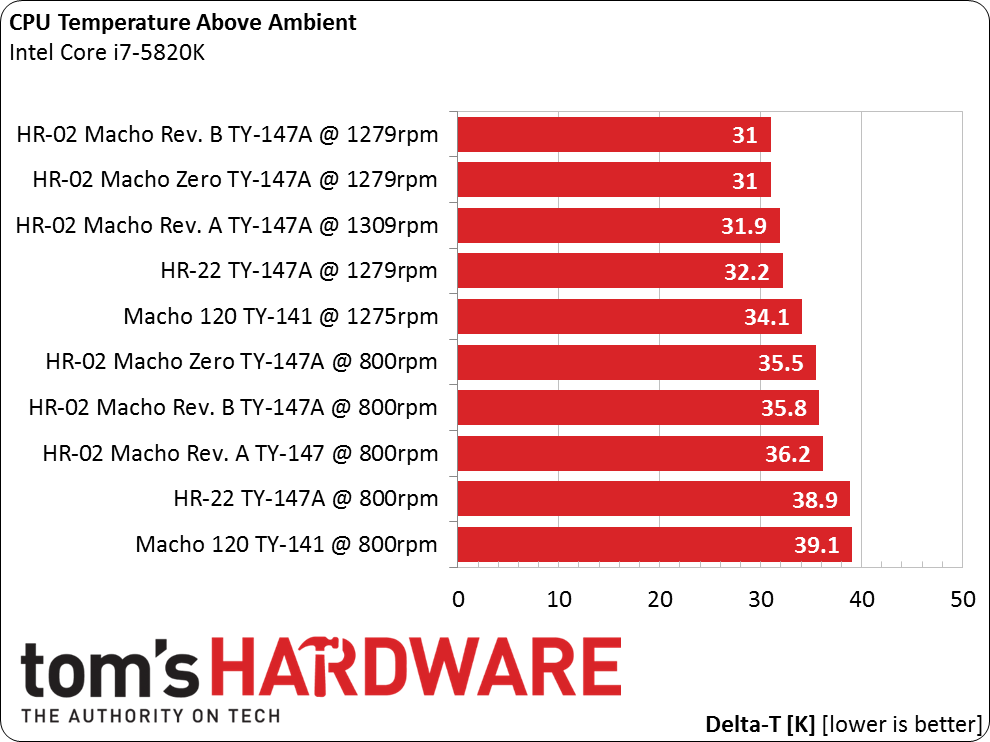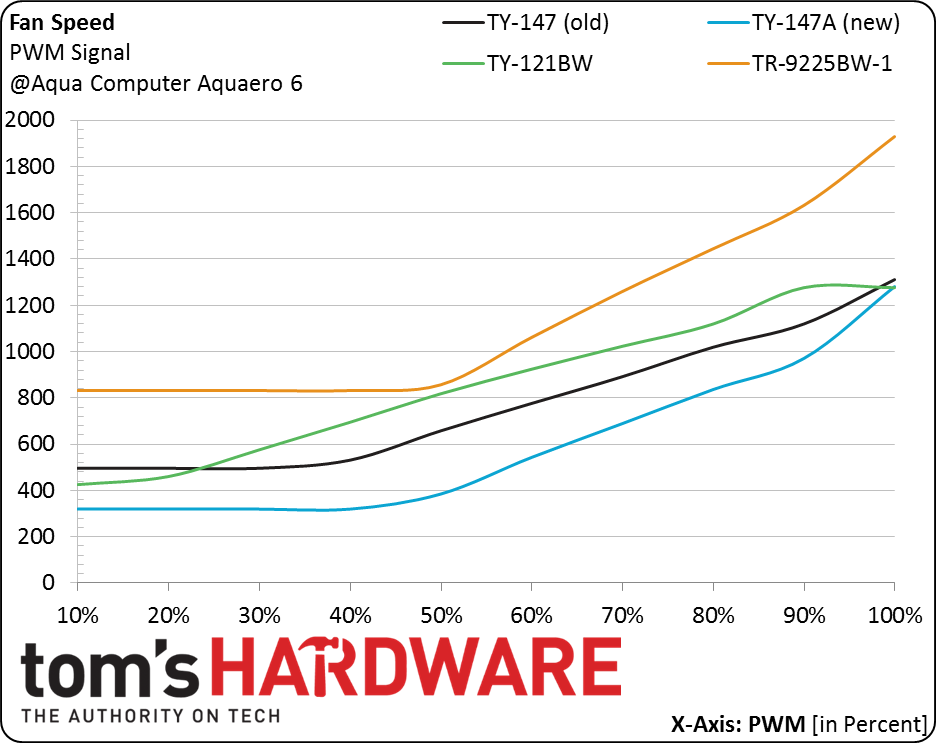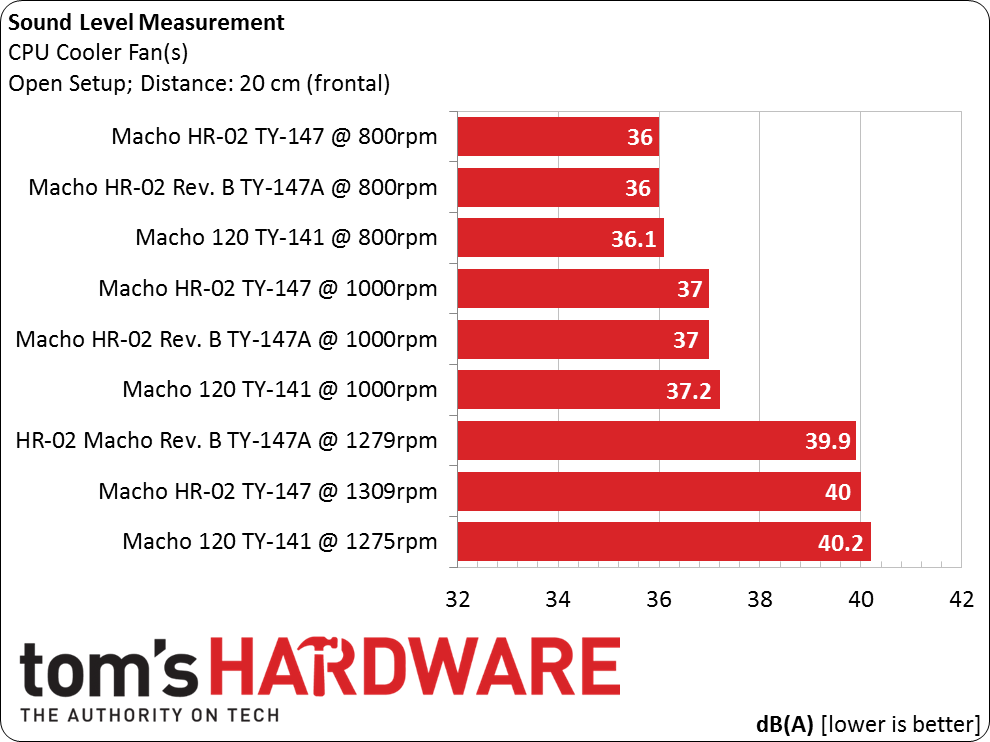Thermalright Macho Heat Sink Family Round-Up
We've seen several versions of Thermalright's HR-02 Macho since 2011, including the smaller Macho 120 and the huge HR-22. We tested the latest iteration, which sports a new base plate optimized for Intel's LGA 2011-v3 interface.
Results: Cooling Performance, RPM Curve And Sound Level
Cooling Performance
Not surprisingly, the HR-02 Rev. A and B are similar. By precisely controlling the test environment, we were able to confirm that the newer revision does enjoy a minor performance advantage, as a slightly more expensive version should.
In spite of utilizing eight instead of six heat pipes, the HR-22 doesn’t perform much better. In semi-passive mode, the HR-22 "merely" performs on a par with the HR-02 in active mode, but it limits your RAM choices and even fares slightly worse than the HR-02 at reduced fan speeds.
However, we were positively surprised by the little Macho 120 Rev. A. While it has only five heat pipes, is shorter and less wide than the HR-02, its cooling performance is only slightly lower. That's an admirable feat for a 6“ cooler.
RPM Curves
The latest Macho revision sports the TY-147A fan, which can operate at a low 300 RPM. The difference between our TY-147 and TC-147A samples wasn’t that significant at all. Perhaps that's because our TY-147 worked down to 497 RPM (a whopping 400 RPM less than its spec sheet promises). Don’t count on this, though. Deviations of 10% are expected; any more than that and you’re just lucky (or unlucky).
Thus, we expected the TY-147A to spin down to 330 RPM. And it did. In fact, it continued on down to 317 RPM.
Note that some motherboard fan controls cannot go below a certain minimum speed. Thus, if you cannot get the TY-147A to run at 300 or 330 RPM, your platform may be to blame.
When we determined the RPM curves, we started at 10 percent and cranked up the power to 100 percent. If you go the other way, the curves will look slightly different. Thus, even measurements determined by the Aquaero 6 fan controller may contain some inaccuracies. But they should be good enough for reference.
Get Tom's Hardware's best news and in-depth reviews, straight to your inbox.
When you look at the fan speed curves, you'll notice that both fan generations were optimized for quiet operation. The PWM signal needs to go beyond 40% to 50% for the fan to gradually gain speed.
When your primary goal is low noise, the brand-new TY-147A behaves even better than its predecessor. While the TY-147 starts at a higher speed and goes beyond 1000 RPM at a duty cycle of approximately 80%, the TY-147A stays quiet much longer and only exceeds 1000 RPM slightly above 90% duty cycle, and then rapidly gains another 300 RPM.
The TY-147A’s top speed is higher than the TY-147’s, which means that the TY-147A stays quiet in most situations and only revs up when high temperatures really call for more fan airflow.
Sound Level Measurements
As we try to measure minor differences between quiet fans, we modified the sound level test procedure slightly. This time, we measure at a mere 8“ distance straight in front of the fan, at the height of the fan bearing. If you think the reported sound level is alarmingly high, remember that these values cannot be compared to results gathered from our regular test method, which sports a closed case, not an open test platform. A close-range, open-air measurement like this one is greatly affected to the exact position and angle of the sound level meter. Change the position slightly and massive deviations can result. Thus, take these test results with a grain of salt. Our primary motivation for this unusual test setup was the comparison of both TY-147 generations.
Both fans are pleasant to listen to. We had to hold our ears to the fan to detect a slight bearing noise. This is as good as it gets, and the TY-147A sounds slightly better than its predecessor. But a difference as small as this one may even arise from manufacturing variations.
We record the sound level at each fan's maximum speed, at 1000 RPM and at 800 RPM. Any lower than that and a fan inside a case is not audible except, perhaps, in a sound-proof room. Whatever we tried, the TY-147 fans proved to be equally loud. The faster-turning model is ever-so-slightly louder, but this can be attributed to typical manufacturing variations.
As we crank up the RPM duty cycle towards 90%, the TY-147A turns slower and is thus also quieter. Once you go beyond that, both fans get louder. However, at 800 and 1000 RPM both fans exhibit identical sound levels.
Current page: Results: Cooling Performance, RPM Curve And Sound Level
Prev Page Comparison Test: Cooler And Fan Next Page Thermalright's Macho Evolves-
nucas And... were is Noctua?Reply
If these coolers are the benchmark for competing brands, were are they.
-
cib24 This was a great read and very informative with regards to the Thermalright CPU coolers. I hope that the next article by Kai Tubbesing is a comparison test of CPU coolers and is written with the same attention to detail and careful testing procedures.Reply -
Onus Reply"...the updated model not only comes with a few design improvements like nickel-plated heat pipes and a black paint job for the topmost cooling fin..."
Please use the word "changes" instead of "improvements" unless you can show better cooling performance attributable to these two things.
"Indeed, the HR-02 Macho Rev. B stands out from the crowd."
With not a single other member of "the crowd" in these tests, this statement is meaningless marketing drivel, and the whole article nothing more than an advertisement. Particularly as a Moderator, I try not to be critical of the site, but this might be the worst example of misrepresentation I've ever seen here. I think you can do a LOT better.
-
mapesdhs Alas I agree, without comparisons to existing coolers (and please dear grudReply
include a normal TRUE!) the article is useless. Are any of these better than
the venerable NH-D14? The equivalent Phanteks? What about an H80? One
cannot make a purchasing decision based on the summary. I'm sure toms
wouldn't do a GPU roundup based on a single manufacturer's product line,
eg. Zotac; readers would rightly want to know how they compared to ASUS,
EVGA and all the others.
I'm glad I started doing a particular thing with cooler reviews before I invest
time reading from the start: I go straight to the results page, and if it doesn't
have coolers from other vendors then I don't bother reading. What people
want is something like this. Ditto reviews for fans, etc.
Ian.
-
jtd871 SPCR's recommended heatsinks summary provides a good comparison of heatsink performance (cooling performance/noise level) and links to the original reviews for more detailed information. It helps that SPCR has standardized on a 130W TDP CPU as the heat source in order to provide an 'apples to apples' comparison.Reply
I will credit Tom's for doing a better job of reporting on performance and noise over the range of the fan speeds recently. -
Calculatron Reply15183168 said:Alas I agree, without comparisons to existing coolers (and please dear grud
include a normal TRUE!) the article is useless. Are any of these better than
the venerable NH-D14? The equivalent Phanteks? What about an H80? One
cannot make a purchasing decision based on the summary. I'm sure toms
wouldn't do a GPU roundup based on a single manufacturer's product line,
eg. Zotac; readers would rightly want to know how they compared to ASUS,
EVGA and all the others.
I'm glad I started doing a particular thing with cooler reviews before I invest
time reading for the start: I go straight to the results page, and if it doesn't
have coolers from other vendors then I don't bother reading. What people
want is something like this. Ditto reviews for fan reviews, etc.
Ian.
Boom goes the dynamite.
http://www.tomshardware.de/cpu-kuhler-test-prozessorkuhler-cooling-cpu-cooler,testberichte-241700-7.html
The German Tom's Hardware team has been delving into cooling for the last couple months, which explains why we have been getting some of the articles we have being thrown our way. (This article was published about a month ago, I think?)
I actually hope that Tom's Hardware does more round-ups like this, and I hope that they do the testing for the True Spirit family of Thermalright heatsinks next. The more data we have that is like this, and have it in one place, the better off we all are. And the less we'll feel the need to see it as a requirement to include something like an Noctua NH-D15, or Cooler Master Hyper 212 EVO.
-
Onus Yes, but this wasn't a "round up;" it was a showcase of a single company's products. The data presented may be 100% reliable (and I hope I didn't imply that it wasn't), but without comparative results from other products, does not assist in making a buying decision or otherwise judging the merits of the coolers.Reply -
dovah-chan Well considering how many benchmarks there are including all the coolers such as the Phanteks PH_14TCPE, Noctua NH-D15, Cryorig R1 Universal, be quiet! Dark Rock Pro 3, and many others, it should be pretty obvious where/what these products stack up at.Reply
This is just a general evaluation of a lineup of coolers. Just go find another site that benches at a similar setting with a 5820K or comparable socket 2011 CPU and go look at it and stop complaining about them not having results when there are already tons out there that you can take two minutes to look up and compare to.


